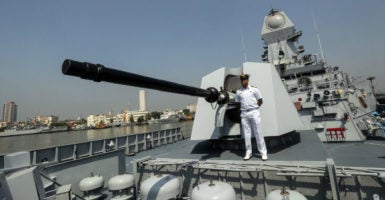While much of the focus for U.S. naval diplomacy remains centered on the Asia-Pacific, Chinese activity in the Indian Ocean region is a growing concern, given the large amount of trade that passes through the area.
The U.S. can counter growing challenges in the Indian Ocean by expanding and regularizing cooperation with India, the predominant naval power in this region.
A key facet of the current U.S. approach to naval strategy in the Indo-Pacific region involves the cultivation of regional partners to improve security.
The most recent maritime strategy document for India also emphasizes cooperation with foreign navies, creating an opportunity for the U.S. to expand naval relations as both seek partners to deal with maritime challenges.
This also assumes that stronger relations at the tactical and military level will positively influence the broader strategic relationship.
When it comes to disputes in the South China Sea, India has somewhat limited motivation to actively oppose China because of its differing view from the U.S. on freedom of navigation operations, and tends to support a more restrictive view of military activities in exclusive economic zones.
Directing the relationship away from such a contentious issue could make Indian policymakers more willing to engage with the U.S. on regional security.
Additionally, India has tended to hedge between the U.S. and China and to refrain from taking strong positions on disputes in the South China Sea. That is why the Joint Strategic Vision for the Asia-Pacific and Indian Ocean Region signed by the U.S. and India in January 2015 was so significant.
In that document, both sides affirmed that maritime security must be safeguarded and freedom of navigation and overflight must be guaranteed throughout the region, especially in the South China Sea.
The statement made clear that both India and the U.S. are interested in curbing China’s maritime and territorial ambitions.
Focusing U.S.-India naval cooperation on the Indian Ocean and the waters to the west of India (i.e. the Arabian Sea) would likely gain more traction than a focus on the Asia-Pacific, since the Indian navy sees its primary areas of interest to its west.
Indian trade, including energy out of the Persian Gulf, is primarily west-centric, and the major maritime chokepoints that trade flows through are also to the west. Thus far, however, most of the naval cooperation with India has been conducted by the U.S. Pacific Command, which primarily covers the area to India’s east.
The creation of the Chinese naval support facility at Djibouti and the development of the Pakistani port of Gwadar, though, are issues that will probably occupy more Indian attention.
>>> India’s Increased Naval Capacities Are Good for Regional Security
The Indian Ocean is split between three U.S. commands—not just Pacific Command, but also Africa Command and Central Command.
All three have seen more Chinese activity since China deployed submarines to the Indian Ocean, continues to upgrade the facility at Djibouti, and sent ships to Gwadar.
Therefore, the U.S. should seek to expand cooperation with India via U.S. Central Command and Africa Command.
Similarly, focusing on routine areas of cooperation as opposed to politically risky initiatives would allow the naval relationship to grow and regularize, and would insulate it from possible ups and downs in the broader political relationship.
Expanding the annual Malabar exercise and focusing cooperation on humanitarian assistance and disaster relief operations and training are both key ways that cooperation could be enhanced with little political risk.
Convincing India to sign remaining foundational cooperation agreements, the Communications Compatibility and Security Agreement and the Basic Exchange and Cooperation Agreement for Geospatial Intelligence, is essential to enabling this cooperation.
These agreements are standard practice for U.S. partners and would not inhibit Indian strategic autonomy or lead to the U.S. basing its naval forces in India, as some critics in India believe.
Rather, they would greatly enhance interoperability and cooperation, as U.S. commanders are legally constrained by the law without them.
By laying a broad foundation for enhanced naval cooperation now, the U.S. would be in a better position if it required Indian naval assistance on more politically sensitive issues down the line.
































